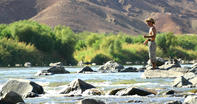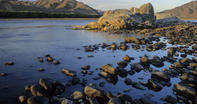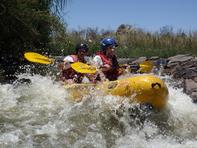A New Group of Explorers
In the 1770s, a new group of explorer’s entered Namaqualand. They were the scientists, ornithologists and botanists who were attracted by the region’s bizarre plants and unusual fauna. This group included Francis Masson, a botanist from Kew Gardens who was sent by the king of England to collect seeds and live plants for the royal greenhouse.

Masson spent many years travelling the globe, including two tours of South Africa in 1772-1774 and 1786-1795. He collected Stapeliads from the Kamieskroon district in 1774. Masson was often accompanied by another notable collector, Carl Thunberg, the ‘father of Cape Botany’.
Together, they visited the southern edge of Knersvlakte, near Vanrhynsdorp, also in 1774. Two major contributors to the western canon of knowledge on Namaqualand were Robert Jacob Gordon and William Paterson. Gordon, a Hollander, was a prolific traveller who undertook several extensive journeys across South Africa.
It was during one of these trips, in 1777, that he came across the ‘Great’ river near Bethulie and named it the Orange, in honour of the Royal House of Orange, rulers of Holland. Gordon suspected that this river ran all the way to the sea, but he could not prove it at this stage.
Finding the Mouth

Then, in 1779, Gordon teamed up with a regular travelling companion named William Paterson to try and find the mouth of the Orange River. Paterson was a young British botanist who had been sent to the Cape by his eccentric patron, Lady Strathmore. He enjoyed some controversy during his stay in South Africa. At one time, he was accused of being a British spy and, later, it was said that he had discovered gold on the banks of the Orange River, but kept the secret to himself.
In any case, Paterson had already been to the banks of the Orange in 1778 when he had checked out the old copper mines around present-day Springbok, which he found to be promising. So, he was familiar with the region when he and Gordon set off to the north.
A short distance out of Cape Town, they were fortunate enough to run into Hendrik Wikar, a clerk of the Dutch East India Company, who had fled Cape Town in 1775 because of unpaid gambling debts. Wikar had subsequently spent several years wandering along the Orange River in the company of some friendly locals and wrote an informal report on the region, which he sent to the Dutch Governor, Van Plettenberg. This report was deemed to be so useful that the governor pardoned Wikar, who was on his way back to Cape Town when he met up with Paterson and Gordon.
No doubt, Wikar gave the two explorers valuable information about their upcoming journey. Even so, the trip was arduous. The soft sand of the Sandveld was always tough on travellers, but Gordon and Paterson were determined to keep to the coast instead of heading west to harder ground.
So they persevered and continued to push their way from the Buffels River (near present-day Kleinzee) to MacDougalls Bay (near present-day Port Nolloth) and then through the Holgat River Gorge, until they reached the Orange River Mouth on 17 August 1779. This short stretch of about 120 km took them nine days.
Naming the Orange River

When they arrived, they unpacked a small boat which they had brought with them and, according to Paterson, ‘launched (the boat) and hoisted Dutch colours. Colonel Gordon proposed first to drink the State’s health, and then that of the Prince of Orange; after which he gave the river the name of the Orange River in honour of that prince.’
This second naming ceremony was probably made because Gordon wasn’t sure if this was the same river he had seen at Bethulie. They then landed the boat on the north bank of the river, where they met some Strandlopers, whom Gordon sketched. The next few days were spent exploring the large bend in the Orange, which curves around the modern Richtersveld National Park.
The explorers subsequently returned to the Buffels River, where they parted ways; Paterson headed for Cape Town and Gordon returned to the Orange and following the river eastwards to the Prieska area, presumably to satisfy himself that this was indeed the same river he had first named in 1777.
By David Fleminger